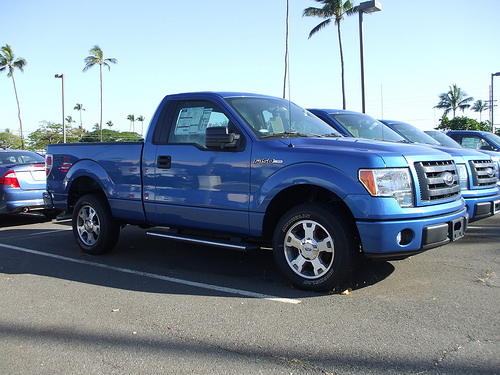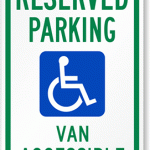Is it your car, or are parking spaces shrinking?
Standard parking spaces measure 9 feet by 18 feet, but the 2014 Ford F-150—the most popular vehicle in the United States—measures a little over 8 feet by 19 feet. That gives its passengers trying to get out of the truck about 6 inches on either side—and that’s if the truck is perfectly parked in an average-sized spot.

Is your parking getting tighter, or is it just that your car’s getting bigger? From CC-by-CarlImages.
The example may be one of the most extreme since the Ford F-150 is one of the larger vehicles in the country, but it does point to one of the many unintended consequences resulting from America’s continued attraction to big cars and trucks.
Another is the rise in auto bodywork. “My truck has, like, a million dents in the door,” says Georgia Stewart of Fargo, ND.
When she parks in “the little spots,” as she calls them, Stewart says her large truck always gets nicked or scratched. “I got some estimates, and it’s going to cost,” she says.
Those kinds of issues will decrease in the future as cars become smarter, automakers say. Cameras, proximity sensors, and other collision-avoidance features currently found only on luxury vehicles will likely become the norm, helping more drivers sidestep accidents.
But such features don’t affect car size, which won’t decrease if Americans’ waistlines keep expanding. Notes Dan Cheng of business consultancy AT Kearney, the number of adult Americans classified as obese has paralleled the rise in the number of light trucks—the auto sector that includes minivans, SUVs, and pickup trucks—since the 1970s.
And the figure is only expected to grow: predictions have 43% of Americans classified as obese in 2018, a 3% rise from 2011. That forecast doesn’t bode well for sustainability advocates who would like to see more fuel-efficient cars on the road. The most fuel-efficient are those that are lighter and smaller, but such vehicles don’t work for larger Americans who find them uncomfortable.
Says Karen Steelman, a homemaker from Athens, GA, who has a body mass index of roughly 37 (seven points above what’s considered obese), “I want to be environmentally friendly, but unless I am in an SUV these days . . . I find it hard to find pleasure or comfort in driving.”
Still other large Americans voice concern about the safety of smaller cars. “Even if I could eventually fit under the steering wheel of the car, my next worry would be surviving a car accident,” said Robert Dean Cole, a Wisconsinite who weighs 240 pounds and stands 6 feet 7 inches.
Perception doesn’t match reality, however. Carmakers have accounted for the lower mass of smaller vehicles in collisions with their larger counterparts, and many get as good or better ratings in crash tests than bigger vehicles. The 2013 Honda Civic received a four-star crash rating from federal government, for instance, higher than the Ford F-150 and other larger crossovers and SUVs.
Related Posts
Category: Regulations, Transportation

















